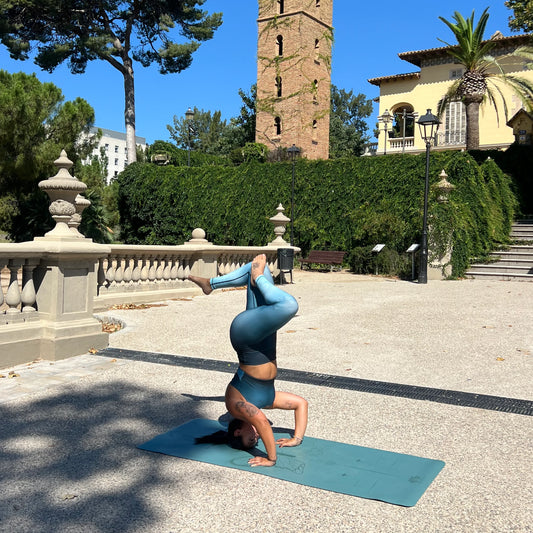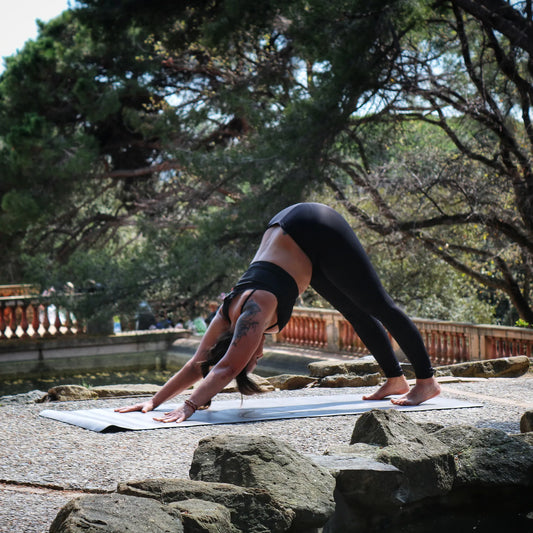The Basis of Yoga: The Eight-Step Path:
As we have seen, the Yoga Sutras ("Aphorisms of Yoga") are the ancient foundational texts of yoga, written by the sage Patanjali.
One of the most important texts explains a practical and technical guide to ensure that the development of yoga practice is complete and precise.
Patanjali divided this guide into eight parts or limbs. Therefore, this teaching is known as Ashtanga Yoga (where " Ashta " means eight and " Anga " means parts or limbs).
Think of this as a map for living Yoga.
These eight parts are:
YAMA:
It means "restriction" or "control"; how we relate to the world. It is the first step on the path. Consider it as the ethical and universal principles for living in peace and well-being with our environment.
This step is divided into five principles, considering them both inside and outside the yoga class, and these are:
- Ahimsa: (non-violence). Physical, mental, and spiritual. This principle is about observing violence in our environment as well as within ourselves.
- Sayta: (truthfulness, authenticity, and sincerity). Acting in a way that is true to oneself and authentic , based on the truth that makes us who we are and the sincerity of what we feel and naturally are.
- Asteya: (not stealing, not appropriating what does not belong to us ). Here we consider the term "not stealing" to delve into the personal and profound interpretation of what "stealing" means to each individual. This includes wasting other people's time, appropriating knowledge and/or positions without experiencing them, envy of another, among other things.
- Brahmacharya: (restraint, moderation). Avoiding not only excess but also deficiency. The information we receive in our daily lives, the management of our energy, what we ingest, our desires, etc.
- Aparigraha: (non-greed, non-ambition). Once again, an invitation to live from detachment, to let go of the unnecessary in order to nurture and cultivate the deepest, truest, and most enriching aspects of life. It implies renunciation and freedom simultaneously. Letting go of certain postures, joint angles, or durations of holding that may also seduce us in Aparigraha.
NIYAMA:
It is also divided into five parts and has been interpreted as a series of behaviors, this time, oriented towards oneself.
- Sahuca (both external and internal cleansing): It is the cleansing (physical/textual) along with the habits (physical, mental, and spiritual) that guide to a higher level of consciousness .
- Santosha (contentment): It is the pleasant and holistic feeling of well-being. It is experienced as you gradually go through the practice of Yoga, feeling how the "hurry" dissolves and disappears.
- Tapas (discipline): Tapah translates as "heat, inner fire": Our inner heat that is cooked (from the root tap: to cook) and transformed through simplicity and the practice of Yoga.
- Svadhyaya (self-study): the study of scriptures in Yoga is "the study of oneself"; the scriptures speak of us, of me, of you.
- Ishvara-pranidhana (surrender to the divine): Surrender understood as acceptance, letting go of control. Allowing things to happen as they are.
ASANA:
A series of exercises that go beyond mere physical activity. Asana is a meditative technique and one of self-discovery through the body ; therefore, the fundamental aspect of yoga practice is mindfulness . We will delve deeper into this topic on our blog soon ✨.
🧘Yoga Mat "A Mind Full of Dreams" (Beige)
Click on the image to see the mat with laser engraving. ✨
PRANAYAMA:
The fifth branch of this path deals with the mind-body connection ; the word "prana" refers to vital energy obtained through the connection between breath and mind when it is conscious, deep, and controlled.
PRATYHARA:
Interiorization, withdrawal of the senses. It is the ability to detect external stimulation through the five sensory organs without allowing it to alter the mental state. Instead, it is about knowing how to direct them towards the interior.
DHARANA:
This concept means mental concentration. The mind gets distracted and is brought back, again and again. It is the active act of fixing the mind on a single point (object, mantra, breath), serving as an anchor that gives the mind a fixed place to rest . By giving it this single task, the mind stops jumping between thoughts ("mental noise").
DHYANA:
This step is often translated as meditation . It is the uninterrupted flow of attention to that point in a natural way, where effort disappears.
SAMADHI:
It is said that the difference between the last three limbs of Ashtanga Yoga lies only in the matter of gradation and deepening. Samadhi is interpreted as the ultimate goal of Yoga , and is impossible to understand through definitions. Where the Self, the mind, and the object of meditation merge into one.
Discover HERE the unique and special design for you of Namastecita mats to take your practice to the next level! ✨ 🥰
💬 We Want to Read Your Opinion!
Tell us what you thought of this article. Is there a topic you'd like to see in the next blog? We're listening! 👇
Namaste! 🧘









